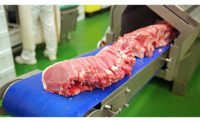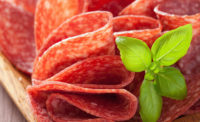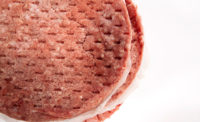Processing
Cutting equipment: A ‘Cut” above




In the meat industry, product is variable with different moisture contents, thicknesses, lengths and more for which to account on a cutting line. Although processors constantly have to fine-tune cutting equipment for yields, cutting equipment nowadays offers ways to help.
For starters, vision systems are more widely used to identify the anatomical landmarks on carcasses to guide operators and cutting equipment, says John E. Johnson, general manager at JBS USA. Processors now need not rely on experience, he adds.
Colorado Premium is one processor that has added laser cutting equipment with cameras, a move that has vastly improved the yield from hand cut, says Jeff Swartz, plant engineer.
“We get a closer weight,” he explains.
With cutting machines now able to make a calculation of where to slice, processors now have an easier time cutting for more than one ounce size. Blades can come down in a split second to cut conveyed meats to the correct thickness or ounce size.
“There are ways to calculate ounce sizes to maximize the yield from any particular muscle that the machine is cutting,” says Franklin Hall, CEO of Lone Star Foodservice, Austin, Texas.
Lone Star Foodservice operates a single-blade machine that makes a single cut.
“That cut is as good [as] or better than what a meat cutter can do because it’s a single motion,” Hall explains. “Sometimes when you see a steak being cut, you might see a sawing action — back and forth — that can end up with a steak that wouldn’t have the best appearance. The single cut is outstanding for that fact.
“The laser slicer, if it’s programmed appropriately and the product is trimmed just right, really can cut a lot of steaks,” he adds. “It’s very efficient, and it can also get us a better yield.”
Better slicing
Equipment manufacturers are continually looking at ways to improve their equipment. For example, the support tools have improved to reduce the variability of the human being, such as the error-free Mousetrap to steel knives and sharpening equipment for knife rooms, JBS’s Johnson says.
Blade technology is an ongoing process as well. Colorado Premium has tried different blades, including Teflon- and non-Teflon-coated blades and super-hard metal blades. The company currently uses a hardened, stainless, non-Teflon-coated blade, Swartz says.
Continually training with the operators and attention of knife room personnel to a scheduled maintenance of the knives and blades for the equipment is essential to maintaining sharpness, Johnson adds.
Technology that has been used in poultry cutting — water jet cutters — is migrating to beef and pork cutting as well.
“It is not as much cutting on the carcasses, but trimming and cutting further-processed pieces such as steaks and chops,” Johnson says. “Utilization of vision systems will be the common platform whether manipulating traditional cutting blades or knives or other means such as water jets.”
Cutting equipment advancements are sure to include ways to improve cleaning and sanitation. For example, Hall has seen improvements to design that help to eliminate standing water, making equipment easier to dry.
Newer, more advanced cutting equipment also translates to more progressive technologies being introduced, so training of equipment operators is a continual process.
“Our operators are definitely better than they were five, six years ago,” says Dan LaFleur, vice president of operations at Colorado Premium. “With all the equipment that comes in and all the technology, they’ve got to understand it’s not just snapping a blade on a machine and hitting the ‘on’ switch. They need to understand, when their yields are off, to stop the machine, how to tune the machines and how to set the belts up right. A lot of that isn’t a maintenance function. It’s more of an actual employee-on-the-line function, understanding how a machine works.”
Hall agrees that as processors automate more, cutting equipment operators are going to require additional skills that they didn’t need before.
“Instead of cutting a steak using our eyes and our hands and coordinating to get that steak to be cut, a machine is doing that for us,” Hall explains. “We have to understand the capability of the machine and how we need to calibrate and adjust the machine to do the best job.”
Looking for a reprint of this article?
From high-res PDFs to custom plaques, order your copy today!











